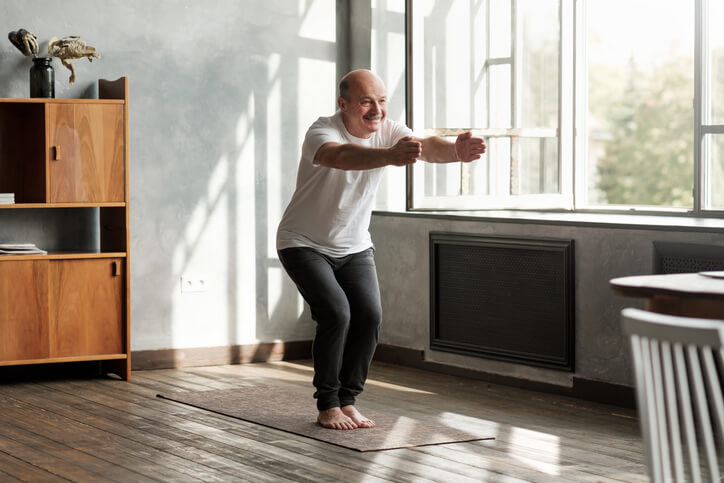Your mental health matters throughout your lifetime. Whether you had a rough childhood or an idyllic one, whether you experienced a midlife crisis or not, a healthy mindset makes all the difference as you age. The challenges associated with later life—caring for aging parents, strained relationships, memory loss, and more—may be unavoidable. But by focusing on your mental health by practicing mindfulness, you’ll not only enjoy a more fulfilled adulthood—increased energy and focus, elevated mood, improved memory—you may also curb your risk of developing dementia.
We want to help you enjoy life at any age, so we’ve compiled this resource guide that includes:
- Advice for making mindfulness part of your everyday life
- Simple ways to practice meditation
- Real-life stories of achieving mental wellness
Why Mindfulness Matters for Healthy Aging
While you can’t prevent aging, there’s also no reason to fear it, says Sherry Skyler Kelly, a West Hartford-based clinical neuropsychologist and licensed psychologist, who began her training in mindfulness practices in 1992.
“The good news is we have a lot more control over our aging than we at first realize,” says Kelly. In the therapy and coaching work she does across the country, Kelly has evaluated adults of all ages through a variety of cognitive changes.
She found that adults follow a pattern of wellness or decline, and the path they take is heavily linked to one area: lifestyle choices. This led her to create a “MAKE-it-positive” plan for healthy aging that involves having each of these elements in your life every day:
- M = Mindfulness, Meditation, Mood, Mindset & Music
- A = Activities & Action (Behavioral Activation)
- K = Keeping Connected to Others & Social Support
- E = Exercise & Energy Work
Reducing Stress by Practicing Mindfulness
Even if you make the choice to embrace a healthy lifestyle, how can mindfulness help reduce stress in your daily life? Joy Rains is author of “Meditation Illuminated: Simple Ways to Manage Your Busy Mind” and host of the podcast “Mindful 180” and she believes it all comes down to staying present.
“Since mindfulness helps you experience life in the ‘here and now,’ you may notice tension that you hadn’t noticed before,” says Rains. “For example, you might realize that your breathing is shallow or your muscles are tense or that you’re adding to your stress by imagining negative scenarios. Becoming aware of tension can help you release it.”
Practicing mindfulness is possible anytime by simply pausing and checking in with your body, Rains says. “Notice your breathing, even for one breath. Feel the soles of your feet as they touch the ground when you walk. Notice the feeling of the water as you wash your hands.”
Meditation in Five Easy Steps
You can also learn to become mindful by practicing meditation. Rains offers these simple instructions to get started.
First, choose a consistent time and location, such as a chair or floor cushion in a quiet room. Start with 2 to 3 minutes daily, setting a timer if needed. As you become used to meditating, gradually increase your time to 15 to 20 minutes. Try to fit in at least a few minutes a day to maintain a routine, Rains recommends.
For your daily routine:
1. Start by sitting up straight, without being rigid. Keep your spine aligned with your head and neck. Gently close your eyes. Try to release any physical tension, keeping your body relaxed but your mind alert.
2. Choose an anchor—a neutral object or idea to focus on that doesn’t stimulate your mind. Examples of commonly used anchors include your breath, your body, a word repeated silently, such as peace; sounds, such as ocean waves; or an object to hold, such as a smooth stone.
3. Rest your attention on your anchor. Every time your mind wanders, gently refocus on your anchor. For beginners, this may be as often as every second or two.
4. Accept your wandering mind. The intent of meditation isn’t to suppress thoughts and feelings. Consider anything that draws attention away from your anchor to be like a cloud passing or like a boat floating by as you watch from the riverbank. Allow it to pass without judgment and gently refocus on your anchor—the repetitive action of refocusing trains you to become mindful.
5. Continue gently refocusing on your anchor for the rest of your practice time. Repeat this cycle each time you practice meditation.
Learn more about the benefits of meditation for older adults.

10 Steps to Better Mental Health Through Mindfulness
Better mental health is a whole-body practice. Consider these methods from mindfulness experts to boost your wellness from wherever you are, whatever your background or mental health status. Remember, these are daily practices, so be patient with yourself as you establish these healthy habits.
1
Be Active
Exercise for at least 30 minutes, 4 to 5 times a week. The release of neurotransmitters such as serotonin and dopamine will improve mood, says Cassandra Hill, a gerontologist, certified wellness coach, and holistic health practitioner. Walking is a great way to stay active.
2
Eat the Rainbow
Enjoy a variety of colorful fruits, vegetables, and legumes. A balanced plate will enhance your physical health and your mental health. In fact, some studies have shown that just by eating fruit, you can increase your feelings of happiness, Hill adds.
3
Have a Support System
These individuals will hold you accountable in self-care and help you engage in activities to prevent isolation, says Hill. Resources like NAMI, the National Alliance on Mental Illness, also has resources if you need help finding resources or building your support team.
4
Talk to Someone
Sometimes just verbalizing your problems to a kind ear offers a relief valve when you’re suffering and can ease anxiety levels, says Jeffrey Butch, MS, MSN, APRN, clinical hypnotherapist and co-founder of Mindhealth Clinical Hypnotherapy.
5
Eat Good Mood Foods
Your gut microbiome hosts over 90% of your body’s serotonin receptors, which brings a whole new meaning to the saying, “You are what you eat,” says Swanson Health’s registered dietitian and nutritionist, Lindsey Toth, MS, RD. “Some feel-good foods include dark chocolate, which provides nutrients like magnesium to help calm the mind, and avocados, which give a B vitamin boost for coping with daily stressors.”
6
Maintain Intergenerational Connectedness
In today’s busy society, older family members may feel disconnected, irrelevant and unappreciated—and strained or estranged relationships can be a catalyst for anxiety or depression, says author Lisa Swift-Young. By sharing some wisdom from your life journey with younger family members, you can bridge that gap and foster more meaningful connections.
7
Change Your Focus
If you’re spending hours a day following every breaking news announcement, especially if it’s negative, you’re going to be in constant distress, says Peggy Sealfon, personal development coach, productivity strategist, motivational speaker and author. “Turn off the digital news flow—TVs, tablets, cell phones. Listen to your inner voice and turn off depleting thoughts of overwhelm or hopelessness.”
8
Meditate on a Consistent Schedule
It’s better to meditate for 10 minutes each day than an hour three times a week. This is because of how the mind and brain function,” says Jaya Jaya Myra, a best-selling author and TEDx Speaker. “Consistency helps to rewire your neural connections to form better habits.”
9
Do Something You Love Everyday
Establish a daily routine doing something you love. This is more important than sitting to meditate, Myra says. “When you take at least 10 minutes a day that’s just for something you enjoy, it’ll be much easier to take 10 minutes for something you feel you need to do (like meditation).”
10
Feed Your Soul
Your body gives you cues when you need to fuel up. When you’re thirsty, your lips may be chapped or your throat may feel dry. If you haven’t eaten in a bit, you may hear your stomach rumble or feel light-headed. But when your soul is hungry, the signs are more subtle. Maybe you feel a bit more tired, or generally meh. Whatever your symptoms, it’s important to feed your soul before you notice any cues, whether they’re minor or major.
Practicing Mindfulness and Meditation in Real Life
Find hope and motivation in these real-life stories of thriving in the midst of life’s challenges.
Donna F. Brown – Practicing Mindfulness Through Yoga
“I have experienced my fair share of anxiety, depression, grief, loneliness and mental illness throughout the course of my lifetime,” says Donna F. Brown, a 68-years-young author, musician, certified yoga instructor and retired registered nurse who currently lives in a small rural community in Pearce, Arizona.
After bouts of tinnitus (ringing in the ears) and chronic pain from endometriosis—which brought on depression, anxiety, grief and other health issues—Brown felt isolated, alone and desperate for change.
“When I resumed practicing yoga and meditation, they taught me discipline in my practice both physically and mentally. The more disciplined I became in my meditation practice, the less despairing, anxious, lonely and isolated I felt,” she says.
After becoming a yoga instructor, Brown taught the same principles she learned as a student. She also taught yogic breathing techniques to her patients when she worked as a nurse and found them to be very effective for overcoming mental and physical health issues.

Cameron Cromwell – Practicing Mindfulness Through Martial Arts
Shortly before his 56th birthday, Cameron Cromwell found himself unemployed.
He was grateful to leave a toxic work environment, but Cromwell was filled with uncertainty and anxiety from mounting financial pressures that included a new mortgage and his daughter’s college education.
As his family continued in their day-to-day norm, an isolated Cromwell struggled to maintain a positive mindset, and he missed the social interaction of the workplace.
Exercise gave him a starting point—and it was also the tipping point in his mindfulness journey.
“One day, on a complete whim, I attended a free kickboxing taster session. No physical contact, just exercise and some basic techniques,” he says. “It was high-energy and filled with people of all ages that wanted to be healthier and stronger. I loved it.” Before long, Cromwell was attending every class.
From grappling to Brazilian Jiu-Jitsu, Cromwell learned that martial arts was about more than physical fitness. The practice emphasized good nutrition, a healthy mindset, better sleep and new social connections. He’s now the founder of Absolutely Martial Arts, a website that provides information on getting started with martial arts. “It was the positive social interaction full of encouragement that I needed,” he says.

Key Mental Health & Mindfulness Takeaways
Anxiety, depression, dementia, grief and loneliness may be common experiences in later life, but the good news is they don’t define you. You’re not alone, and you can do something about these feelings.
Keep these mental health wellness practices in the forefront, no matter what challenges come your way:
- Stay active in a variety of ways.
- Remain connected to friends, family and community.
- Become focused through meditation and a positive mindset.
- Stay engaged in hobbies new and old.
How have you incorporated practicing mindfulness to boost your mental health in later life? Tell us in the comments below.
If you’re looking for more ways to bring wellness to your life, check out our 30-day Wellness Challenge, where you’ll find simple daily activities designed to remind you that wellness is a journey, not a destination.







This is my first time seeing this. As most people, I have struggled alot in my past yet, now, about to be 70, I find
I have left out my own needs, wants, happiness, preservation of my mind and wellness, for many, many years now. My husband has Alzheimers and presently still home. My wonderful Grandson I’ve been raising for 7 yrs. now. He was severely Traumatized until 10, so I put him first. My Daughter, well she has not liked me much since she was 10, the most meaningful time we’ve shared was 12 weeks ago when I had her moved from the Hospital to Palliative and Hospice Care. I spent th last 12 days of her life with her. She only had her Heaing left, so I talked to my daughter for 12 days, around the clock. I told her just how much I have loved her, what she’s meant to me, I explained the Journey she was about to take so she would not be afraid. God would be waiting for her with Open Arms and a Great Smile. That she would never be Sad, Lonely, Abused, Hungry, Cold,
Again. She had been Homeless for some years. I’d stroke her face, her hair, hold her hand, all while talking to her. It just killed me when I placed her in God’s Hands. She left me her Son who is my pride an joy.
I need All of these Mental, Emotional, steps I just read, to bring myself back, and find joy, love, peace. I thoroughly enjoyed reading these articles and plan to be in better mental health before I loose my husband also.
Thank You, I’ve been sitting in the post office parking lot reading and writing this, that’s how much I got from All of this.
Mary
I love The Hartford, you give out the best articles and the most informative I’ve ever seen. The Evacuation List is the Best I’ve ever seen. The teeth cleaning is something I love and need. The Mindfulness of Older Adults is beyond helpful, it’s important for me and everyone out there. Thank you, Hartford, you too are THE BEST!!!
Thank you for such a nice comment, Nina!! We’re so glad you like our posts!
Very good information. Thank you
Even the meditation-and-the-brain studies have been rolling steadily for numerous years with new studies developing more or less every single week to exemplify a fresh advantage of meditation. The clinic seems to possess a remarkable assortment of neural benefits — from fluctuations in gray matter amount to reduced activity from the”me” centers of their brain to enhanced connectivity between brain regions.
This article came at the right time for me because since I turned 80 in November, there are changes added to my being at home and cannot go anywhere with all these new strains of Covid now in Sacramento.
In addition to feeling shut off from my relatives and friends, I can’t go to Church like i used too, shopping for my groceries and freedom of walking through the neighborhood.
This article helps me not to focus on what I cannot do and focus on what I can do to help me
stay healthy both mentally and physically. Thank You so much for this article at the right time for me.
Only wanna input that you have a very nice site, I love the style and design it really stands out.
I have read all of these comments! I have found myself in a rut! Turned 81 Friday and am going thru marital problems and separation! I have been doing a lot of sitting and staying on a tablet to much playing games! I am going to try the 30 day challenge and do more walking! Also going to try to mediate! It is so easy to get in a rut and just sit here and do nothing! Prayers for better judgement and efforts!
Everything does get harder as you age, but staying connected with friends, family (as much as you can), and God is essential for your well-being. Make choices to love, forgive and extend kindness. If you are down, nothing lifts you up as much as bringing joy to someone else. Make friends….be a friend. Staying away from the negative things that tilt your emotions is so important. Good food, plenty of exercise and getting involved in some kind of community is vital to your mental well-being. When your mind is at rest, your energy and zest for life increases. Test your mind with puzzles, teasers, problem solving.
If you are dealt lemons, make lemonade. Almost everything can be turned into something good. I heard one person say, who had overcome cancer, God don’t let me waste this opportunity to help someone else who suffers with this. Look for opportunities to be an encourager. Life is precious; people are amazing; God is good.
Great ideas! Will try to put some of them into practice.
Let us know how it goes!
Be very careful to whom or what you turn your mind over to. Jesus is the ONLY name to depend on. He has a blessed plan for your life at any age! He loves you, is on your side, wants to prosper you in all you do and is waiting on you to call upon His name. Meditate on God’s love, unbreakable promises and His word!
I have read many of these ideas and they sound very good. I have had ongoing issues with anxiety sadness and loneliness. I am 71 years old and I live alone COVID-19 is also a stressor. Even though I’ve been home since March 6, and unemployed ,my goal is to go back to school as a substitute teacher because not only do I need the extra money as I live on a fixed income but I need to keep busy and go back to the classroom setting. One of two things that has been difficult for me to deal with is related to family issues. I have a five-year-old grandson that I have not seen in over a year. I have a son that has had a substance-abuse problem for years and I see it’s taking it’s toll on him. We are trying to encourage him to get help but it’s just a matter of time to see what he decides to do because he does not see his kids. All of these things have taken their toll because you just cannot turn your back and pretend that things are not well. First and foremost I miss my grandson more than words can say and there are many times when I cry. Also with regards to my son I am still a parent and I don’t have the power except through prayer that he find the strength and guidance to move on to help himself. My doctor has recommended that I get an emotional support dog so I am looking for one. I find that as you get older it becomes more difficult to cope. All I can do is the best I can each day.
I stay active and keep busy. My phone is set for going to sleep at 10:00 and rising at 6:00. I walk every morning. I do other exercise at the gym or home. I love to play cards. I joined corn hole. I go out for dinner once a week and cook my own meals. I also like to bake. I am not bored during this Covid 19 time. God bless all of us.
I learned the grounding exercise from a counselor I went to, which was on a walk to pick out 5 things you can see, 4 things you hear, 3 things you can touch, 2 things you can smell, and 1 thing you can taste. Another exercise you can do while relaxing at night in bed is to tense certain muscles in your body for 10 second, relax them for 20 seconds, and then go on to the next set of muscles. It helps to do this just before going to sleep. Sometimes I don’t get through all of them before I do fall asleep.
Nancy – great suggestions!
I’m 84. I walk 3miles twice a week and other times a mile in the evenings in my condo complex.
This leads to interacting with wonderful neighbors. I do pretty well with fruit but not veggies.
Before covid 19, I worked 3 aftns a week in my church office. I really miss that, I could interact with people and it gave me a feeling of feeling needed.
I take meds for clinical depression.
Until I read the article, I didn’t really understand how to meditate. I am going to try starting
Shirley – Let us know how the meditation goes!
Heck, I can’t focus long enough to read this article let alone do ‘mindfulness’. I tried these sessions as led by a therapist and it’s not for me so, I’m still looking for other outlets and so far, it’s music that works for me.
I enjoyed and wrote in my tablet the meditation eating habits etc I do need help With applying myself for anything but hard work is all I’ve ever known
Thank you for the comment, Edna 🙂